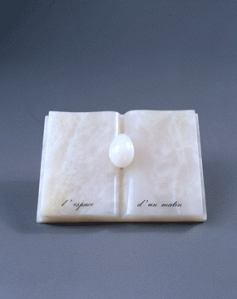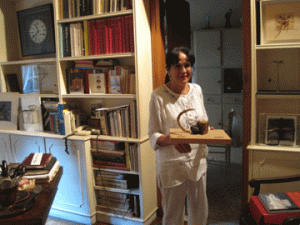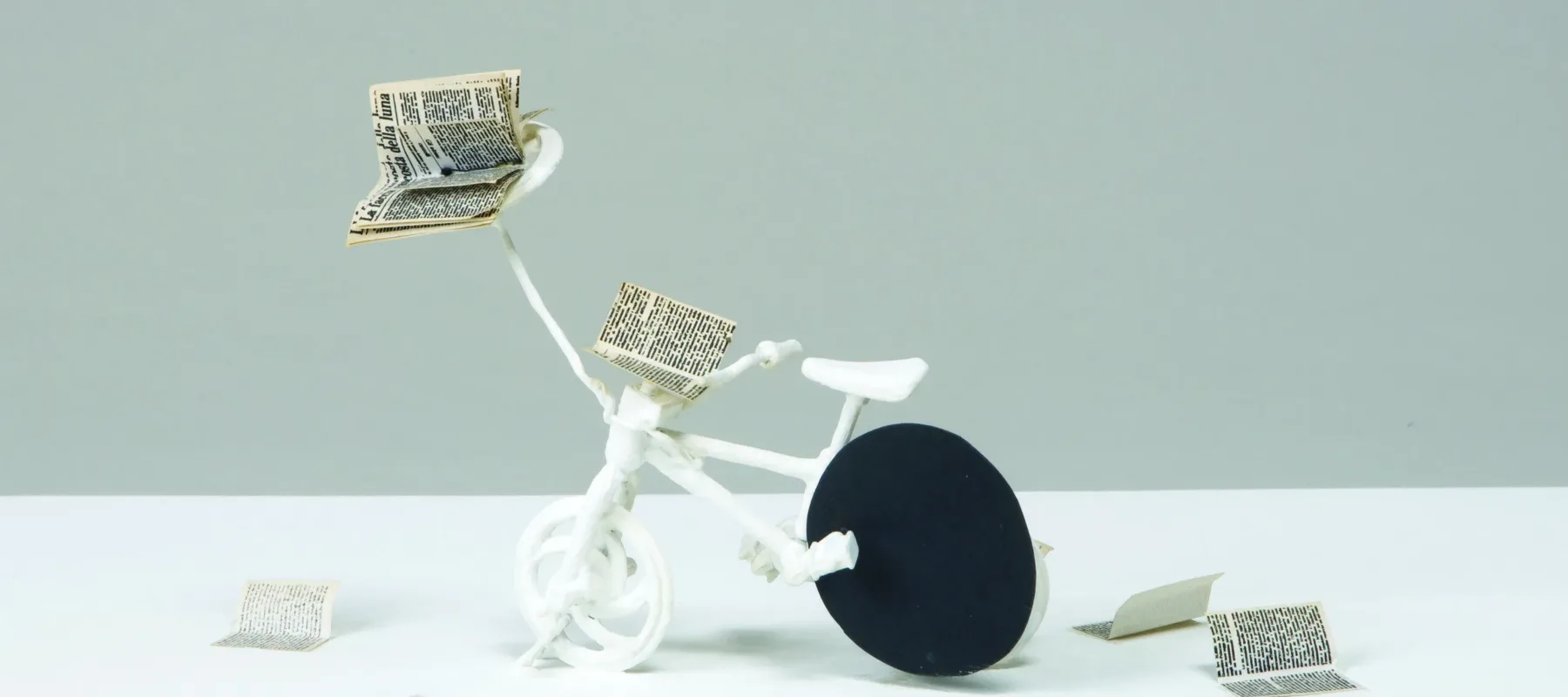In this series of blog posts, NMWA Curator of Book Arts Krystyna Wasserman recounts a recent trip to Europe:
The focus of a journey could be the exploration of a new territory or a spiritual journey in search of internal peace. It could also be the need to assuage one’s desire for friendship, love, or adventure or, simply, finding an inspiration for creative work. My trip to Germany and Italy in September 2011 was focused on viewing works created by women, on meeting artists, particularly book artists, and on cultivating old friendships.
Part V: Women Artists of Rome
In 1985, when the National Museum of Women in the Arts was still located in its temporary headquarters on MacArthur Boulevard in Washington, D.C., (the museum opened in its present location in 1987) we received a letter and a package of photographs of artists’ books and libri oggetti (book-objects) from Italian artists Mirella Bentivoglio and Elisabetta Gut, offering to donate any work we liked to the museum’s collection. Mrs. Holladay and I reviewed the photographs. We loved the works and decided to select Bentivoglio’s A Malherbe and Gut’s Libro-seme (Seed-book). They were the first foreign artists who donated artists’ books to the collection, and we were very excited and grateful for the gift. Subsequently both artists donated many more works to NMWA, and both were given solo exhibitions: Bentivolio in 1999, The Visual Poetry of Mirella Bentivoglio and Elisabetta Gut in 2010, Books Without Words.

Mirella Bentivoglio is an extraordinary person of many talents. She is best known in Europe for her exploration of the relationship between language/word and image. Unlike most poets, Bentivoglio presents poetry “liberated” from the traditionally printed page. The artist plays with words, breaks rules of syntax, detaches words from phrases, and isolates letters from words. The results of these experiments—concrete and visual poems—are perceived as symbols and metaphors. She also creates unique artists’ books, often made from unusual materials such as marble, wood, and earth, and publishes limited-edition portfolios.
She is a renowned sculptor and performance artist. Her public sculpture, The Egg of Gubbio, has been celebrated for years by the citizens of that small Umbrian town. She curated many exhibitions of women artists in Italy and all over the world, and she has participated in the Venice Biennale 10 times, as well as in over 900 solo and group exhibitions. Her concerns, often reflected in her work, are protection of the environment and critique of conspicuous consumerism and thoughtless waste. For her 90th birthday, next year, the National Gallery of Contemporary Art in Rome will present a retrospective exhibition of her work. Most recently, in November 2011, the Museum of Modern and Conteporary Art of Trento and Rovereto (MART) celebrated her major gift, Donation Bentivoglio, of over 300 works of visual poetry and artists’ books by Italian and foreign artists from her private collection.
Bentivoglio has lived dangerously. As a young woman after the World War II, she and her future husband, then a law student, participated in the anti-fascist demonstrations in Northern Italy in Pavia and Milan. One of their favorite anti-establishment activities was whistling in the theaters in Milan, which at the time produced a conservative repertoire that was supportive of the establishment. To protest, a group of students would go to the theater every night, with camouflaged whistles in their pockets; they whistled from many seats located all over the theater during the performance. They were known as “The Whistlers”, Bentivoglio assured me that it was a good tactic, because the following season the theater’s program included Thornton Wilder’s Our Town. “The Whistlers” then relaxed and stopped whistling.

Bentivoglio is an extraordinary cook. Her fennel salad with oranges and walnuts, her delicious vegetable stews made of eggplants and tomatoes, and homemade pastas with pesto are some of the best dishes I have ever tried anywhere in the world. If weather permits, meals are served on her balcony overlooking a beautiful garden marked by the cypress trees. When the sun goes down, it is like being inside a landscape of a Renaissance painting. This September it was too cold to eat on the balcony, and we sat in her small, blue-wallpapered dining room, eating from beautiful blue china dishes set on a blue tablecloth. My present to her was a blue apron, which she said inspired this blue lunch.
Like many artists, Bentivolio sees in works of art the details invisible to the eyes of other mortals. An example of her poetic imagination occurred in the post office. She noticed a bunch of labels with the sign “fragile,” the sign we often attach to parcels with glass dishes or other delicate contents. Bentivoglio took some of the labels and made a book titled “The World after September 11” (presently in NMWA’s exhibition Trove, until January 15, 2012.) She found the sign “fragile” as the word defining the world after September 11, 2001. “We are surrounded by potential symbols,” says Bentivoglio, “to be discovered in moments of poetic insight and preserved with the help of forms, words, and materials.”
Bentivoglio’s research has brought recognition to many forgotten women artists, in particular to those who were active in the futurist movement. She co-authored, with Franca Zoccoli (as I have mentioned in Part I of my report from Rome), a 2008 book, Le Futuriste Italiane nelle Arti Visivi and published a 2010 portfolio, Futurismo ex Novo (Futurism Anew) describing and reproducing the verbo-visual poetry of Marietta Angelini (1868–1942) who was a maid and lover of Filippo Tommaso Marinetti (1876–1944), the founder of futurist movement. Angelini’s poetry known as ”parole in liberta” (words in freedom) is a kind of a private diary in which she alludes to her sexual adventures with Marinetti and depicts a busy life of a woman in a domestic space. Futurismo ex Nove has been recently donated to NMWA.

Elisabetta Gut’s recent exhibition Books Without Words, in 2010, was enthusiastically received by NMWA’s visitors. Many recorded their impressions in the exhibition guest-book, which the artist asked us to photocopy and send to her to Rome. Gut reported that reading and rereading visitors’ remarks is the best medication she knows for her gloomy days and blue moods. It uplifts her spirits instantaneously.
Among the visitors to the show was Joseph Eisenberg, Cultural Director of Maitland Regional Art Gallery, in Maitland, Australia, who fell in love with Gut’s art. He asked NMWA to travel the show to Australia, but we had already arranged the return of the exhibition to Rome and it was not possible. Mr. Eisenberg persisted, and in October this year he and his curator went to Rome to select the works for Gut’s 2012 exhibition in Maitland. When I visited the artist this September, Gut showed me her new works, which will travel to Australia for the Maitland show. They were pure poetry and magic, and I wished I could present another exhibition of her works at NMWA.

Even though I had been to Rome before, I had never seen Bocca della Verita (the Mouth of Truth) located in the portico of Santa Maria in Cosmedin Church. It was a sentimental journey inspired by one of my favorite films, Roman Holiday, with Gregory Peck and Audrey Hepburn. In one of the movie’s scenes, Peck puts his hand into the stone “mouth of truth,” which is supposed to bite the hand of a liar. The line of tourists was too long to verify my truthfulness, but my curiosity was assuaged. I also made a pilgrimage to Via Margutta 51, where Peck, who played the role of an American journalist in love with a princess (Hepburn), lived in a modest apartment. It had not changed much since 1953, when the film was made.

The other news of interest to our bloggers might be the information about a Georgia O’Keeffe exhibition (October 4, 2011–January 22, 2012) taking place in Rome in Palazzo Cipolla on Via del Corso. The show is curated by one of her biographers, Barbara Buhler Lynes. Another great woman painter, Artemisia Gentileschi, enjoys great glory in Milan, where an exhibition of her 40 major works is on view in Palazzo Reale (Royal Palace) through January 29, 2012.
Finally, I would like to share with you the recipe for my new favorite drink, which I tried for the first time this year in Italy. If you take a walk in the afternoon inVenice, you will notice in almost every outdoor cafe people sipping red liquid from their glasses. This is a Spritz, a mixture of Prosecco and Campari, with a slice of orange and some ice. Cin-cin!

